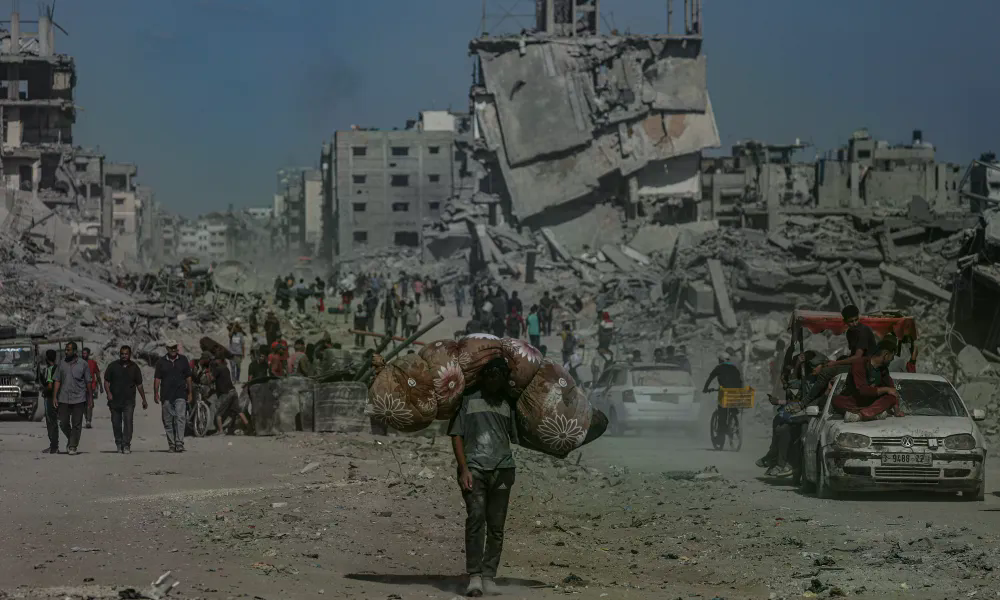
Gaza City has seen a return of residents following the ceasefire between Israel and Hamas. Many have returned to assess the damage, salvage what they can, and begin the long process of rebuilding their lives. However, the experience of returning home is marked by uncertainty and fear.
In areas such as Jabalia, Sheikh Radwan, and Abu Iskandar, people have returned to neighborhoods that were reduced to rubble. Among the debris, some undetonated explosive devices remain, posing a lingering threat. Residents are unsure where these devices might be or how to respond if they encounter one, deepening their sense of anxiety.
These devices, referred to as “robots,” have become a source of fear in northern Gaza since the Israeli military began using them in May 2024, particularly in the Jabalia refugee camp. According to a report by Euro-Med Human Rights Monitor, their deployment increased dramatically in the lead-up to the October ceasefire, with approximately 300 residential units destroyed daily in Gaza City and Jabalia.
The devices are armored carriers loaded with explosives and dragged into position by armored bulldozers. Once in place, soldiers remotely detonate them, causing widespread destruction within a radius of up to 500 meters. The extent of the damage to infrastructure has been described as “staggering” by officials from Gaza City Civil Defence.
For many, the use of these devices has introduced a new form of terror. Sharif Shadi, a 22-year-old from Jabalia, recalls hearing a sound he had never encountered before during Israel’s ground assault on northern Gaza. It was the sound of the explosive robots, which subsequently devastated entire neighborhoods. On one occasion, Shadi witnessed a robot being brought into his neighborhood and narrowly escaped the blast, which left him buried under rubble.
Days later, Shadi lost a friend who was caught in another explosion while trying to reach a hospital. The friend’s body was completely vaporized, leaving no trace behind. Such incidents have led to growing concerns about the humanitarian impact of these weapons.
According to Euro-Med’s report, the indiscriminate and widespread destruction caused by these devices places them in the category of prohibited arms. Their use in populated areas is considered both a war crime and a crime against humanity. However, neither the Israeli military nor the government has publicly acknowledged the use of these weapons, despite some media reports highlighting their deployment.
Beyond the immediate destruction, the devices also leave behind toxic vapors and gases, leading to severe respiratory problems among civilians. Dr. Mohammed Abu Afash, director of the Palestinian Medical Relief Society, notes that the fumes cause suffocation and breathing difficulties, often containing dangerous chemicals like lead.
Residents describe the smell as a mix of gunpowder and burned metal, lingering in the air and making it difficult to breathe. Um Ahmed al-Dreimli, a mother of three, recounted how the explosions came without warning, creating a heavy metallic rumble that felt as though the ground was being pulled from under her feet.
Mohammed Abu Tamous, from the Civil Defence and Ambulance media department, has observed the use of these devices across multiple areas in northern Gaza. He describes how they are used to destroy entire rows of buildings, erasing landmarks and complicating rescue efforts. In some cases, the damage is so extensive that it becomes impossible to identify streets or locations.
During the January ceasefire, his team discovered an unexploded device in Tal el-Zaatar, which contained an unidentified yellow, paste-like substance. While the nature of this material remains unclear, it stands out from other explosives encountered.
As people return to Gaza City, concerns over the presence of unexploded devices persist. Abu Tamous warns that the current response is limited—only perimeter warnings can be issued, as bomb disposal teams lack the necessary equipment to handle the situation effectively. He emphasizes the need for more resources to address the ongoing threat.
This report was produced in collaboration with Egab.


